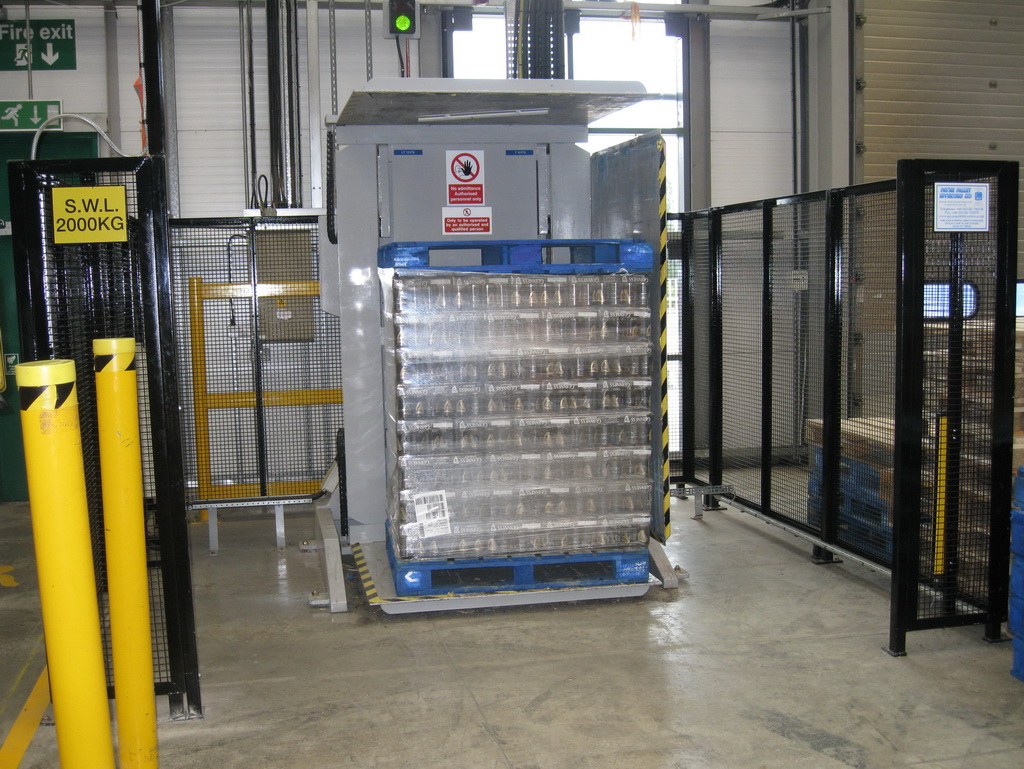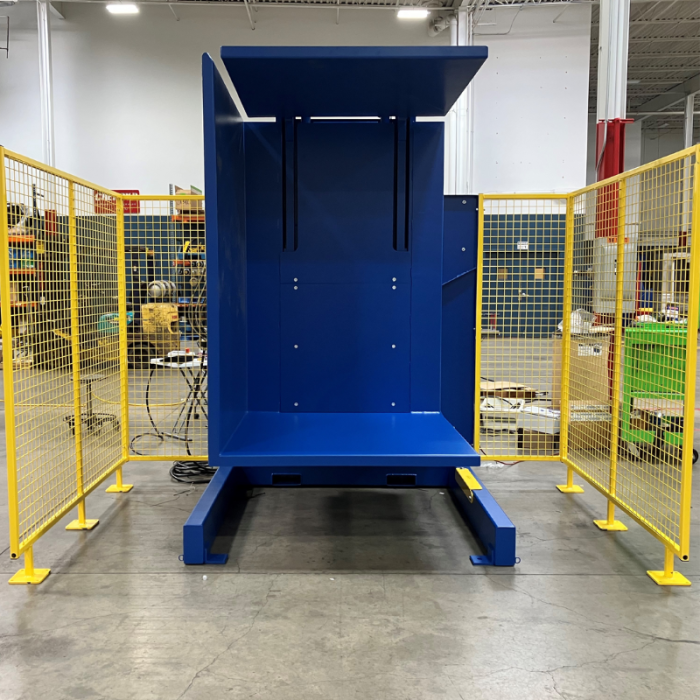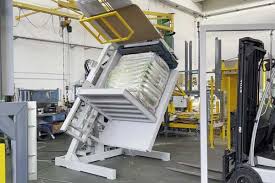Is Your Argentina Factory Struggling with lower downtime in agri-export processing plants? Try a Pallet Changing Machine
The pressure on agri-export processing plants in Argentina is immense. You're dealing with perishable goods, tight shipping schedules, and global customers who expect perfection. Any delay, any stoppage on your line, can mean the difference between profit and loss. It's a constant race against the clock. Imagine this: your production line is running smoothly, but everything grinds to a halt at the final stage. A bottleneck forms in the packaging area because your team is manually transferring sacks of grain or boxes of fruit from internal plastic pallets to wooden shipping pallets. This slow, manual process risks product damage, invites worker injury, and, worst of all, creates costly downtime that ripples through your entire operation. There is, however, a powerful and straightforward solution that addresses this exact problem.
Yes, if your factory is facing challenges with downtime, a pallet changing machine is a direct and highly effective solution. These machines automate the entire process of transferring goods from one pallet to another. This eliminates the need for manual restacking, drastically cutting down on labor time and the risk of product damage. By creating a faster, more reliable flow at the end of your production line, a pallet changer directly tackles the root cause of many downtime-related issues in busy processing plants.

Now, you might be reading this from a different industry and thinking, "Vincent, that’s great for agriculture in Argentina, but I run a steel mill in Mexico. How does this apply to me?" It's a fair question. The truth is, the fundamental problem of operational downtime is universal. The principles of efficient material handling are the same whether you're moving bags of soy or coils of steel wire. Throughout my career, I've worked with leaders across many sectors. I've seen firsthand how a bottleneck in the final packaging and shipping stage can cripple an otherwise efficient operation. Let's look beyond the specific industry in the title and explore how this technology offers a total solution for any factory looking to become more efficient, safer, and more profitable.
How can a pallet changer directly reduce operational bottlenecks?
Your production lines are running at full tilt, and everything is moving perfectly. Then, the finished goods reach the end of the line, and suddenly, everything slows to a crawl. A traffic jam forms as workers and forklifts scramble to get products off factory pallets and onto shipping pallets. This bottleneck is more than just an annoyance. It holds up your entire production schedule, wastes valuable labor hours, and consumes precious floor space that could be used more productively. What you need is a dedicated, high-speed solution that breaks this logjam and restores a smooth, continuous flow to your operations.
A pallet changer directly reduces these bottlenecks by replacing a slow, variable manual process with a fast, standardized, automated one. It functions as a dedicated station for transferring goods from your internal pallets, which might be plastic or metal, to the wooden pallets required for shipping. This automated transfer takes only a minute or two, compared to the much longer and less predictable time required for manual restacking. By doing this, it ensures that your production line never has to slow down and wait for the packaging area to catch up.

For a factory owner in a demanding industry like steel manufacturing, this is absolutely critical. Think about the final stage where your finished steel coils or spools of wire need to be prepared for shipment. This is often where efficiency gains from the production line are lost.
The Manual Process: A Recipe for Inefficiency
Let's break down the typical manual process. A forklift brings a pallet of finished goods to the staging area. A team of workers then has to manually unstack the product. They place it onto a new shipping pallet. Then, they have to restack it securely, re-wrap it, and wait for a forklift to take the new pallet away. This process is filled with potential problems. It's slow. It requires multiple workers and a forklift, all tied up in one task. The risk of human error is high, which can lead to unstable loads or damaged products.
The Automated Solution: A Continuous Flow
Now, compare that to an automated workflow with a pallet changer. The forklift simply places the entire palletized load into the machine. The machine clamps the load securely, then either pushes the load onto a new pallet or inverts it 180 degrees to swap the pallet out from the top. The old pallet is removed, and the new pallet is in place. The entire cycle is completed in a couple of minutes with a single operator pushing a button. This creates a predictable, repeatable, and fast-moving process. It transforms the bottleneck into a free-flowing channel.
For a steel mill owner aiming to increase equipment uptime to 95%, this is a key piece of the puzzle. Uptime isn't just about your main production machines; it's about the efficiency of the entire system, from start to finish. I remember a client who ran a steel wire factory. Their packing department was the biggest source of delays. After we installed a pallet changer, the throughput in that single department increased by over 30%. This, in turn, allowed the production lines to run more consistently, helping them reach their overall output goals.
| Feature | Manual Pallet Transfer | Automated Pallet Changer |
|---|---|---|
| Time per Pallet | 15-20 Minutes | 1-2 Minutes |
| Labor Required | 2-3 Workers + 1 Forklift | 1 Operator (part-time) |
| Product Damage Risk | High (due to drops, impacts) | Very Low (load is secured) |
| Worker Injury Risk | High (strains, lifting) | Very Low (push-button operation) |
| Process Consistency | Low (depends on team) | High (standardized cycle) |
What are the safety and product integrity benefits of using a pallet inverter?
In any industrial setting, two of the largest hidden costs are workplace accidents and damaged products. A single serious injury can result in high compensation claims, lost workdays, and a negative impact on team morale. Similarly, a single damaged shipment can lead to rejected goods, financial losses, and a damaged reputation with your client. Manual handling of heavy and often unstable loads is a primary cause of both of these issues. You are putting both your people and your products at unnecessary risk. A pallet inverter, also known as a pallet changer, mechanizes this hazardous task, creating a far safer environment and ensuring your products are handled with care.
A pallet inverter dramatically improves workplace safety by removing the need for manual lifting and restacking. This simple change nearly eliminates the risk of common musculoskeletal injuries that come from repetitive bending and lifting of heavy items. For product integrity, the machine gently clamps the entire load as a single unit before rotating it. This secure handling minimizes the chance of products being dropped, crushed, or damaged, which is a common occurrence when restacking by hand.

When I speak with factory owners, especially in heavy industries like steel, safety is always a top concern. We aren't just talking about boxes of consumer goods; we are talking about heavy, dense products like steel coils or bundles of wire. A dropped load in this environment is not just an inconvenience; it's a potentially catastrophic failure that can damage equipment and pose a severe threat to personnel.
A Safer Environment for Your Team
The ergonomic benefits are clear. Repetitive lifting is a leading cause of back injuries, strains, and sprains in the workplace. These injuries lead to lost time, higher insurance premiums, and can make it difficult to retain good workers. A pallet inverter transforms this high-risk job into a simple, push-button operation. A single operator can manage the entire process safely from a control panel. From my experience in running a factory, creating a safer work environment isn't just a regulatory requirement; it's good business. It shows your employees you value them, which leads to higher morale and better productivity.
Protecting Your Valuable Product
Manual restacking is inherently risky for your goods. Products can be easily scratched, dented, or crushed. Packaging can be torn, leading to contamination or spills. For a steel wire producer, a small kink or scratch from being handled improperly can render an entire spool useless. A pallet inverter treats the entire load as one solid block. It is clamped, moved, and set down with mechanical precision. This consistency is impossible to achieve with manual labor. This level of care ensures that the product that leaves your factory is in the exact same condition as when it came off the production line, protecting your quality standards and your relationship with your customers.
| Risk Factor | Manual Pallet Transfer | Automated Pallet Inverter |
|---|---|---|
| Worker Safety | High risk of back/strain injuries. | Minimal risk, ergonomic operation. |
| Product Damage | High risk of drops, crushing, impacts. | Very low risk, load is secured. |
| Load Stability | Dependent on worker skill. | Mechanically guaranteed. |
| Contamination | Risk of dirt/debris during transfer. | Closed, clean process. |
Can a pallet changer integrate with existing automated systems for a digital factory?
You are making significant investments to build a smart factory. You have Automated Guided Vehicles (AGVs) gliding across the floor, an automated storage and retrieval system (AS/RS) in your warehouse, and a central Manufacturing Execution System (MES) to orchestrate it all. But what happens when your high-tech AGV arrives at a station that relies on a slow, manual process? It creates an "automation island." Your advanced systems are forced to stop and wait for an old-fashioned, analog task to be completed. This completely undermines the efficiency you were trying to achieve with your investment. Modern pallet changers are specifically designed to be the missing link, integrating perfectly into your automated workflow.
Yes, modern pallet changers are built for seamless integration into a fully automated, digital factory. They are equipped with PLCs and communication protocols that allow them to speak the same language as your other systems. This means they can connect directly with AGVs, conveyor belts, and your central MES or Warehouse Management System (WMS). This capability allows the pallet changer to operate as a fully automated station, receiving commands and reporting its status without needing any human intervention.

For a forward-thinking factory owner who is focused on deploying MES, IoT sensors, and data analytics, this integration is not just a feature; it's a necessity. The goal is to achieve total production visibility and control, and that can only happen when every piece of equipment is part of the same digital ecosystem.
Creating a Fully Autonomous Workflow
Let's visualize how this works in a modern steel plant. A finished spool of wire, sitting on a durable in-house plastic pallet, is picked up by an AGV. The MES has already identified this spool for an international order, which requires it to be on a heat-treated wooden pallet. The MES directs the AGV to a pallet changing station. The AGV communicates with the pallet changer, drops off the load, and moves away. The pallet changer, having received its instructions from the MES, automatically swaps the plastic pallet for the correct wooden one. Once the cycle is complete, the machine sends a signal back to the MES. The MES then dispatches another AGV to pick up the now-ready-to-ship pallet and transport it to the automated stretch wrapping station before it goes to the shipping dock. This entire sequence happens without a single person manually touching the product.
Data for a Truly Smart Factory
This integration goes beyond simple automation. A connected pallet changer is also a source of valuable data. Sensors on the machine can monitor cycle times, motor performance, hydraulic pressure, and any error codes. This data is fed back into your MES in real-time. Why is this important? It's the key to predictive maintenance. Instead of waiting for a machine to break down and cause unexpected downtime, your system can analyze the data and flag a component that is showing signs of wear. You can then schedule maintenance during a planned shutdown. This proactive approach is essential for achieving an ambitious goal like 95% equipment uptime. When I was building my own factory, shifting from a reactive "fix it when it breaks" mindset to a proactive, data-driven maintenance schedule was one of the most important changes we made for our overall profitability.
Beyond efficiency, what are the long-term strategic advantages for a factory owner?
As a factory owner, you are constantly balancing short-term needs with long-term vision. Meeting this quarter's production targets is important, but building a business that can adapt and thrive for the next decade is the ultimate goal. Quick fixes and patches might keep things running, but they don't prepare you for the inevitable challenges of the future, such as labor shortages, stricter environmental regulations, or sudden shifts in market demand. Investing in foundational automation like a pallet changer is not just an operational decision; it is a strategic move that builds resilience, flexibility, and sustainability into the very core of your business.
The long-term strategic advantages of a pallet changer go far beyond the immediate gains in speed and efficiency. This investment provides critical operational flexibility, allowing you to easily handle different customer and shipping requirements. It future-proofs your operation against a shrinking labor pool. It helps you comply with international safety and shipping standards. And importantly, it can play a key role in your company's environmental sustainability goals, creating a more circular and less wasteful internal logistics system.

From one business owner to another, I can tell you that the best investments are the ones that solve tomorrow's problems today. A pallet changer is one of those investments. It’s a machine that pays dividends long after the initial ROI has been calculated.
Building Operational Flexibility and Resilience
Markets are volatile. A customer who accepts standard pallets today might require specialized plastic pallets tomorrow. A new international shipping regulation, like ISPM 15 for wooden pallets, might be enforced more strictly. A factory that relies on manual processes will struggle to adapt quickly. A factory with a pallet changer has the built-in flexibility to respond immediately. You can swap between wood, plastic, or even metal pallets on demand, without reconfiguring your entire workflow. This agility allows you to say "yes" to more customers and makes your supply chain more robust and resilient against unforeseen changes.
Addressing Labor and Environmental Pressures
Finding and retaining skilled labor is a growing challenge worldwide. By automating physically demanding tasks, you make your workplace safer and more appealing, and you reduce your dependency on a large manual workforce for logistics. This is a critical strategic advantage for the long term. Furthermore, a pallet changer is a powerful tool for your ESG (Environmental, Social, and Governance) strategy. You can establish a closed-loop system internally using durable, long-lasting, and often recycled plastic pallets. These are only swapped for single-use wooden pallets at the very last moment before shipping. This drastically reduces wood consumption and pallet waste, lowering your environmental footprint and often your costs. This is a powerful story to tell your investors, your customers, and your community.
When I started my own factory, every single dollar of investment had to be justified. I learned very quickly that the machines that solve multiple problems at once are the ones that deliver the greatest value. A pallet changer isn't just a machine; it's a solution that strengthens your business on multiple fronts—operationally, financially, and strategically.
| Strategic Area | Without Pallet Changer | With Pallet Changer |
|---|---|---|
| Flexibility | Rigid process, slow to adapt. | Agile, can swap pallet types on demand. |
| Labor Dependency | High dependency on manual labor. | Reduced dependency, future-proofed. |
| Sustainability | High consumption of wooden pallets. | Enables use of reusable internal pallets. |
| Compliance | Manual checks for pallet standards. | Standardized process ensures compliance. |
| Brand Image | Traditional operation. | Modern, efficient, safe, and green operation. |
Conclusion
A pallet changer is more than a piece of equipment. It is a strategic tool that boosts efficiency, improves safety, and critically, future-proofs your factory for long-term operational success.




